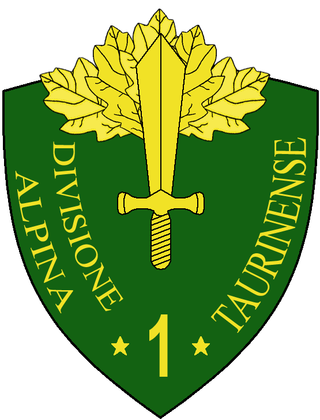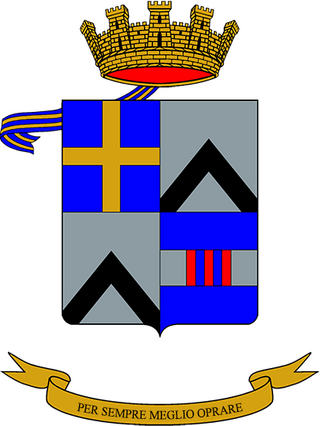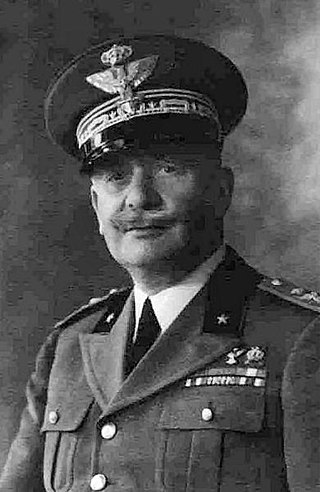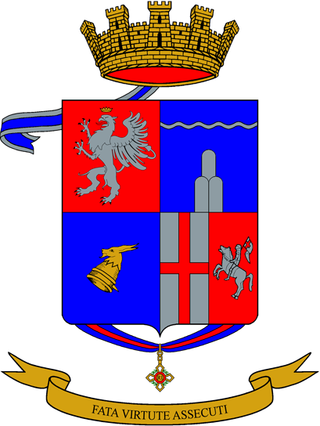Related Research Articles

The 1st CC.NN. Division "23 Marzo" was an Italian CC.NN. division raised on 23 April 1935 for the Second Italo-Ethiopian War against Ethiopia. The name "23 Marzo" was chosen to commemorate the founding date of the Fasci Italiani di Combattimento on 23 March 1919. The division took part in the Italian invasion of Egypt and was destroyed during the Battle of Bardia in January 1941.

The 1st Alpine Division "Taurinense" was a division of the Royal Italian Army during World War II, which specialized in mountain warfare. The Alpini that formed the division are a highly decorated and elite mountain corps of the Italian Army consisting of both infantry and artillery units. Today, the traditions and name of the 1st Alpine Division "Taurinense" are carried on by the Alpine Brigade "Taurinense". The headquarters of the division was in the city of Turin and the majority of its soldiers were drafted from the surrounding Province of Turin — therefore the division was named "Taurinense" for the Roman name of the city of Turin Augusta Taurinorum.

The 4th CC.NN. Division "3 Gennaio" was an Italian CC.NN. division raised on 25 June 1935 for the Second Italo-Ethiopian War against Ethiopia. The name "3 Gennaio" was chosen to commemorate the date of assumption of dictatorial powers by Benito Mussolini on 3 January 1925. The division took part in the Italian invasion of Egypt and was destroyed during the Battle of Sidi Barrani in December 1940.

The 131st Armored Division "Centauro" was an armored division of the Italian Army during World War II. The division was formed in April 1939 by expanding the I Armored Brigade. The division's name came from the mythological race of half human-half horse creatures named Centaurs. The division participated in the invasion of Albania, Greco-Italian War, and invasion of Yugoslavia. In August 1942 the division was sent to Libya to participate in the Western Desert Campaign. After the Axis defeat at the Second Battle of El Alamein the division retreated with the German-Italian Panzer Army to Tunisia, where the division participated in the Tunisian Campaign. On 18 April 1943 the division was disbanded due to the losses suffered in the Battle of El Guettar.
The 203rd Coastal Division was an infantry division of the Royal Italian Army during World War II. Royal Italian Army coastal divisions were second line divisions formed with reservists and equipped with second rate materiel. Recruited locally, they were often commanded by officers called out of retirement.
The 204th Coastal Division was an infantry division of the Royal Italian Army during World War II. Royal Italian Army coastal divisions were second line divisions formed with reservists and equipped with second rate materiel. Recruited locally, they were often commanded by officers called out of retirement.
The 225th Coastal Division was an infantry division of the Royal Italian Army during World War II. Royal Italian Army coastal divisions were second line divisions formed with reservists and equipped with second rate materiel. They were often commanded by officers called out of retirement.

The 151st Infantry Division "Perugia" was an infantry division of the Royal Italian Army during World War II. The Perugia was formed on 25 August 1941 and named for the city of Perugia. The Perugia was classified as an occupation infantry division, which meant that the division's artillery regiment consisted of two artillery groups instead of the three artillery groups of line infantry divisions and that the divisional mortar battalion was replaced by a divisional machine gun battalion.

The 156th Infantry Division "Vicenza" was an infantry division of the Royal Italian Army during World War II. The Vicenza was formed on 10 March 1942 and named for the city of Vicenza. The Vicenza was classified as an occupation infantry division, which meant that the division's artillery regiment consisted of two artillery groups instead of the three artillery groups of line infantry divisions and that the divisional mortar battalion was replaced by a divisional machine gun battalion. The division was sent to the Eastern front, as part of the Italian Army in Russia. The division guarded the army's line of communications and rear area against Soviet partisans.

The 132nd Armored Brigade "Ariete" is currently the only active armored brigade of the Italian Army. Its core units are tank and Bersaglieri regiments. The brigade's headquarters is in the city of Pordenone and most of its units are based in the North-East of Italy. The brigade's name comes from the battering ram. The brigade draws much of its historical traditions from the 132nd Armored Division "Ariete", which fought in the Western Desert Campaign of World War II. In 1948 the Ariete was reconstituted as division and remained active until 1986. Today the brigade is part of the Division "Vittorio Veneto".
With the 1975 reforms the Italian Army abolished the regimental level and replaced it with brigades made up of multiple arms. During the reform the army disbanded 48 regimental commands and reduced its force by 87 battalions. A further ten regimental commands were used to raise ten new brigade commands. Ten training centers, which for traditional reasons had carried the names of regiments, were also disbanded. The reduction in units also allowed to mechanize most of the remaining units in Northern Italy and Italy's defense strategy changed from a hold-at-all-costs territorial defense to one of mobile warfare.

The 3rd Regiment "Granatieri di Sardegna" is a unit of the Italian Army's infantry arm's Granatieri (Grenadiers) speciality. The regiment was active for a short time in 1849 during the First Italian War of Independence and then reformed in 1926 and assigned to the Infantry Division "Granatieri di Sardegna". In 1935-36 the regiment's I Battalion fought in the Second Italo-Ethiopian War. In 1939 the regiment became an autonomous unit and moved to Tirana in occupied Albania. There the regiment was renamed 3rd Regiment "Granatieri di Sardegna e d'Albania" and participated in the Greco-Italian War. For its conduct during the war the regiment was awarded Italy highest military honor the Gold Medal of Military Valour. After the announcement of the Armistice of Cassibile on 8 September 1943 the regiment was disbanded by invading German forces.

The 41st Regiment "Cordenons" is a Surveillance and Target Acquisition unit of the Italian Army. Originally a field artillery regiment, the regiment is today a multi-arms unit operationally assigned to the Tactical Intelligence Brigade, which combines elements of the artillery and signal arms. The regiment is based in Sora in Lazio.

The 107th Signal Battalion "Predil" is an inactive signals unit of the Italian Army. The battalion was formed in 1946 and assigned to the Infantry Division "Mantova". In 1975 the battalion was named for the Predil Pass and received the number 107th, which had been used by the 107th Teleradio Company that served with the Combat Group "Mantova" during the Italian campaign of World War II. With the name and number the battalion also received its own flag. In 1991 the battalion was disbanded and in 2002 reformed as the second signal battalion of the deployable 7th Signal Regiment.
The Maritime Artillery Militia was an artillery unit of Italy's Milizia Volontaria per la Sicurezza Nazionale. It was active from 1939 to 6 December 1943.
Army Group West was an Army Group of the Royal Italian Army in World War II.

Camillo Grossi was an Italian general during the interwar period and World War II. He was also a member of the Italian Senate from 5 April 1939 until his death in office in 1941.

The 21st Infantry Regiment "Cremona" is an inactive unit of the Italian Army last based in Alessandria. Founded in 1848 the regiment is part of the Italian army's infantry arm and named for the city of Cremona.

The 130th Infantry Regiment "Perugia" is an inactive unit of the Italian Army last based on the island of Pantelleria. The regiment is named for the city of Perugia and part of the Italian Army's infantry arm.

The 22nd Infantry Regiment "Cremona" is an inactive unit of the Italian Army last based in Fossano. Founded in 1848 the regiment is part of the Italian army's infantry arm and named for the city of Cremona.
References
- ↑ "Regio Esercito - Storia delle unità terrestri - Gruppo d'Armate Est".
- ↑ Italian Army General Staff, Bollettino dell'archivio storico dell'Ufficio Storico, n. 3-4, Rome, Ufficio Storico SME, January-December 2002
- ↑ "Regio Esercito - Storia delle unità terrestri - Gruppo d'Armate Est".
- ↑ Italian Army General Staff, Bollettino dell'archivio storico dell'Ufficio Storico, n. 3-4, Rome, Ufficio Storico SME, January-December 2002
- ↑ "Regio Esercito - Storia delle unità terrestri - Gruppo d'Armate Est".
- ↑ Alfio Caruso, In cerca di una patria, p. 54